| Revision as of 14:52, 8 April 2020 view sourceDeacon Vorbis (talk | contribs)Extended confirmed users, Rollbackers23,586 editsm Reverted edits by ScarlettCheese (talk) to last version by Citation botTag: Rollback← Previous edit | Revision as of 17:36, 25 April 2020 view source Mbeaniebab (talk | contribs)382 edits →Public toiletTags: Mobile edit Mobile app edit Android app editNext edit → | ||
| Line 136: | Line 136: | ||
| A ] is accessible to the general public. It may be municipally owned or managed, entered directly from the street. It may be within a building that, while privately owned, allows public access, such as a department store, or it may be limited to the business's customers, such as a restaurant. If its use requires a fee, it is also called a ]. | A ] is accessible to the general public. It may be municipally owned or managed, entered directly from the street. It may be within a building that, while privately owned, allows public access, such as a department store, or it may be limited to the business's customers, such as a restaurant. If its use requires a fee, it is also called a ]. | ||
| Depending on the culture, there may be varying degrees of separation between men and women and different levels of privacy. Typically, the entire room, or a stall or cubicle containing a toilet, is lockable. ], if present in a men's toilet is typically mounted on a wall with or without a divider between them. In the most basic form, a public toilet maybe not much more than an open ]. Another form is a street urinal known as a '']'', after the French term. | Depending on the culture, there may be varying degrees of separation between men and women and different levels of privacy. Typically, the entire room, or a stall or cubicle containing a toilet, is lockable. ], if present in a men's toilet is typically mounted on a wall with or without a divider between them. In the most basic form, a public toilet maybe not much more than an open ]. Another form is a street urinal known as a '']'', after the French term. Often times, a public toilet has an automatic sensor controlled flushing system that flushes the toilet when the user steps away from the sensor, and has a button that the user can push to manually flush any extra waste out, such as toilet paper. | ||
| ==Public health aspects== | ==Public health aspects== | ||
Revision as of 17:36, 25 April 2020
This article is about the fixture generally. For the common flush toilet, see flush toilet. For a room containing a toilet, see Toilet (room). For other uses, see Toilet (disambiguation).Piece of hardware for the collection or disposal of human excreta

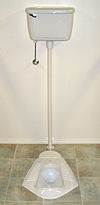
 Toilets come in various shapes and forms around the world, including for flush toilets used by sitting or squatting, and dry toilets like pit latrines.
Toilets come in various shapes and forms around the world, including for flush toilets used by sitting or squatting, and dry toilets like pit latrines.
A toilet is a piece of hardware used for the collection or disposal of human urine and feces. In other words: "Toilets are sanitation facilities at the user interface that allow the safe and convenient urination and defecation". Toilets can be with or without flushing water (flush toilet or dry toilet). They can be set up for a sitting posture or for a squatting posture (squat toilet). Flush toilets are usually connected to a sewer system in urban areas and to septic tanks in isolated areas. Dry toilets are connected to a pit, removable container, composting chamber, or other storage and treatment device. Toilets are commonly made of ceramic (porcelain), concrete, plastic, or wood.
In private homes, the toilet, sink, bath, or shower may be in the same room. Another option is to have one room for body washing (bathroom) and another for the toilet and handwashing sink (toilet room). Public toilets consist of one or more toilets (and commonly urinals) which are available for use by the general public. Portable toilets or chemical toilets may be brought in for large and temporary gatherings.
Many poor households in developing countries use very basic, and often unhygienic toilets, for example simple pit latrines and bucket toilets which are usually placed in outhouses. Globally, nearly one billion people have no access to a toilet at all, and are forced to do open defecation (particularly in India). Diseases transmitted via the fecal-oral route or via water, such as cholera and diarrhea, can be spread by open defecation. They can also be spread by unsafe toilets which cause pollution of surface water or groundwater. Historically, sanitation has been a concern from the earliest stages of human settlements. The Sustainable Development Goal Number 6 calls for "adequate and equitable sanitation and hygiene for all and end open defecation by 2030". In this wise a prototype of a toilet utilizing viscoelasticity has been developed which is practically frictionless.
Overview
The number of different types of toilets used on a worldwide level is large. Toilet types can be grouped by:
- Having a water seal or not (which usually relates to flushing or not, i.e. flush toilet versus dry toilet)
- Being used in a sitting or squatting position (sitting toilet versus squat toilet)
- Being located at a household level or in public (toilet room versus public toilet)
People use different toilet types based on the country that they are in. In developing countries, access to toilets is also related to people's socio-economic status. Poor people in low-income countries often have no toilets at all and resort to open defecation instead. This is part of the sanitation crisis which international initiatives such as World Toilet Day draw attention to.
With water as an odor seal
Flush toilet
Main article: Flush toilet
A typical flush toilet is a ceramic bowl (pan) connected on the "up" side to a cistern (tank) that enables rapid filling with water, and on the "down" side to a drain pipe that removes the effluent. When a toilet is flushed, the sewage should flow into a septic tank or into a system connected to a sewage treatment plant. However, in many developing countries, this treatment step does not take place.
The water in the toilet bowl is connected to a pipe shaped like an upside-down U. One side of the U channel is arranged as a siphon tube longer than the water in the bowl is high. The siphon tube connects to the drain. The bottom of the drain pipe limits the height of the water in the bowl before it flows down the drain. The water in the bowl acts as a barrier to sewer gas entering the building. Sewer gas escapes through a vent pipe attached to the sewer line.
The amount of water used by conventional flush toilets usually makes up a significant portion of personal daily water usage. However, modern low flush toilet designs allow the use of much less water per flush. Dual flush toilets allow the user to select between a flush for urine or feces, saving a significant amount of water over conventional units. The flush handle on these toilets is pushed up for one kind of flush and down for the other. Another design is to have two buttons, one for urination and the other for defecation. In some places, users are encouraged not to flush after urination. Flushing toilets can be plumbed to use greywater (previously used for washing dishes, laundry, and bathing) rather than potable water (drinking water). Some modern toilets pressurize the water in the tank, which initiates flushing action with less water usage.
Another variant is the pour-flush toilet. This type of flush toilet has no cistern but is flushed manually with a few liters of a small bucket. The flushing can use as little as 2–3 litres (0.44–0.66 imp gal; 0.53–0.79 US gal). This type of toilet is common in many Asian countries. The toilet can be connected to one or two pits, in which case it is called a "pour flush pit latrine" or a "twin pit pour flush to pit latrine". It can also be connected to a septic tank.
Flush toilets on ships are typically flushed with seawater.
Vacuum toilet
A vacuum toilet is a flush toilet that is connected to a vacuum sewer system, and removes waste by suction. They may use very little water (less than a quarter of a liter per flush) or none, (as in waterless urinals). Some flush with coloured disinfectant solution rather than with water. They may be used to separate blackwater and greywater, and process them separately (for instance, the fairly dry blackwater can be used for biogas production, or in a composting toilet).
Passenger train toilets, aircraft lavatories, bus toilets, and ships with plumbing often use vacuum toilets. The lower water usage saves weight, and avoids water slopping out of the toilet bowl in motion. Aboard vehicles, a portable collection chamber is used; if it is filled by positive pressure from an intermediate vacuum chamber, it need not be kept under vacuum.
Without water as an odor seal
Main article: Dry toilet
Many types of toilets without a water seal (also called dry toilets or "non-flush toilets") exist. These types of toilets do not use water as an odor seal or to move excreta along. For example, from simple to more complex: a bucket toilet (honey bucket), a tree bog or arborloo (two simple systems for converting excrement to direct fertiliser for trees), a pit latrine (a deep hole in the ground), a vault toilet (which keeps all the waste underground until it is pumped out), a container-based toilet, a composting toilet (which mixes excreta with carbon-rich materials for faster decomposition), a urine-diverting dry toilet (which keeps urine separate from feces), and incinerating and freezing toilets.
Dry toilets use no water for flushing. They also do not produce wastewater. Some of these devices are high-tech but many are quite basic.
Pit latrine with direct drop
Main article: Pit latrine
A simple pit latrine uses no water seal and collects human excreta in a pit or trench. The excreta drop directly into the pit via a drop hole. This type of toilet can range from a simple slit trench to more elaborate systems with seating or squatting pans and ventilation systems. In developed countries, they are associated with camping and wilderness areas. They are common in rural or peri-urban areas in many developing countries. Pit latrines are also used in emergency sanitation situations.
The pit or trench can be dug large enough so that the pit can be used for many years before it fills up. When the pit becomes full, it may be emptied or the hole covered with earth and the pit latrine relocated. Pit latrines have to be located away from drinking water sources (wells, streams, etc.) to minimize the possibility of disease spread via groundwater pollution.
A ventilation improved pit (VIP) latrine adds certain design features to the simple pit latrine which reduces flies from exiting the latrine, thereby reducing the spread of diseases.
Vault toilet
A vault toilet is a non-flush toilet with a sealed container (or vault) buried in the ground to receive the excreta, all of which is contained underground until it is removed by pumping. A vault toilet is distinguished from a pit latrine because the waste accumulates in the vault instead of seeping into the underlying soil.
Urine-diverting dry toilet
Main article: Urine-diverting dry toiletUrine diversion toilets have two compartments, one for urine and one for feces. A urine-diverting dry toilet uses no water for flushing and keeps urine and feces separate. It can be linked to systems which reuse excreta as a fertilizer.
Portable toilet
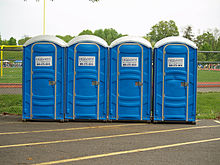
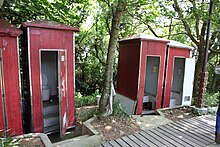
The portable toilet is used on construction sites, film locations, and large outdoor gatherings where there are no other facilities. They are typically self-contained units that are made to be easily moved. Most portable toilets are unisex single units with privacy ensured by a simple lock on the door. The units are usually lightweight and easily transported by a flatbed truck and loaded and unloaded by a small forklift. Many portable toilets are small molded plastic or fiberglass portable rooms with a lockable door and a receptacle to catch waste in a chemically treated container. If used for an extended period of time, they have to be cleaned out and new chemicals put in the waste receptacle. For servicing multiple portable toilets, tanker trucks (vacuum trucks or honeywagons) are equipped with large vacuums to evacuate the waste and replace the chemicals. Portable toilets can also be urine-diverting dry toilets.
A bucket toilet, also known as a honey bucket, is a very simple type of portable toilet.
Chemical toilet
Main article: Chemical toiletChemical toilets collect human excreta in a holding tank and use chemicals to minimize odors. They do not require a connection to a water supply and are used in a variety of situations.
Aircraft lavatories and passenger train toilets were in the past often designed as chemical toilets but are nowadays more likely to be vacuum toilets.
Types by usage posture
Toilets can be designed to be used either in a sitting or in a squatting posture.
Toilet with a pedestal for sitting
Sitting toilets are often referred to as "western-style toilets". Sitting toilets are more convenient than squat toilets for people with disabilities and the elderly.
Squat toilet
Main article: Squat toiletA squat toilet (also called "squatting toilet", "natural position toilet", or by many national names) is a toilet of any technology type (i.e. pit latrine, urine-diverting dry toilet, flush toilet etc.) which is used in a squatting position rather than sitting. This means that the defecation posture used is to place one foot on each side of the toilet drain or hole and to squat over it.
Squatting toilets are the norm in many Asian and African countries, and are common in most Muslim countries. They are also occasionally found in some European and South American countries.
In 1976, squatting toilets were said to be used by the majority of the world's population. However, there is a general trend in many countries to move from squatting toilets to sitting toilets (particularly in urban areas) as the latter are often regarded as more modern.
-
 Squat toilet as seen in some parts of Europe and Asia
Squat toilet as seen in some parts of Europe and Asia
-
 Squat toilet in Topkapi palace
Squat toilet in Topkapi palace
-
 Porcelain squat toilet, with water tank for flushing (Wuhan, China)
Porcelain squat toilet, with water tank for flushing (Wuhan, China)
-
 Old-style squat toilet (Hong Kong)
Old-style squat toilet (Hong Kong)
- Japanese style squat toilet Japanese style squat toilet
Usage
Urination
Main article: UrinationThere are cultural differences in socially accepted and preferred voiding positions for urination around the world: in the Middle East and Asia, the squatting position is more prevalent, while in the Western world the standing and sitting position are more common.
Anal cleansing habits
Main article: Anal cleansingIn the Western world, the most common method of cleaning the anal area after defecation is by toilet paper or sometimes by using a bidet. In many Muslim countries, the facilities are designed to enable people to follow Islamic toilet etiquette Qaḍāʼ al-Ḥājah. For example, a bidet shower may be plumbed in. The left hand is used for cleansing, for which reason that hand is considered impolite or polluted in many Asian countries.
There are toilets on the market where the seats have integrated spray mechanisms for anal and genital water sprays (see for example Toilets in Japan). This can be useful for the elderly or people with disabilities.
Accessible toilets
Main article: Accessible toiletAn accessible toilet is designed to accommodate people with physical disabilities, such as age related limited mobility or inability to walk due to impairments. Additional measures to add toilet accessibility are providing more space and grab bars to ease transfer to and from the toilet seat, including enough room for a caregiver if necessary.
Public toilet
Main article: Public toiletA public toilet is accessible to the general public. It may be municipally owned or managed, entered directly from the street. It may be within a building that, while privately owned, allows public access, such as a department store, or it may be limited to the business's customers, such as a restaurant. If its use requires a fee, it is also called a pay toilet.
Depending on the culture, there may be varying degrees of separation between men and women and different levels of privacy. Typically, the entire room, or a stall or cubicle containing a toilet, is lockable. Urinals, if present in a men's toilet is typically mounted on a wall with or without a divider between them. In the most basic form, a public toilet maybe not much more than an open latrine. Another form is a street urinal known as a pissoir, after the French term. Often times, a public toilet has an automatic sensor controlled flushing system that flushes the toilet when the user steps away from the sensor, and has a button that the user can push to manually flush any extra waste out, such as toilet paper.
Public health aspects
Main article: SanitationTo this day, 1 billion people in developing countries have no toilets in their homes and are resorting to Open defecation instead. The Joint Monitoring Programme (JMP) for Water Supply and Sanitation by WHO and UNICEF is the official United Nations mechanism tasked with monitoring progress towards the Millennium Development Goal relating to drinking-water and sanitation (MDG 7, Target 7c). One target of this goal is to: "Halve, by 2015, the proportion of people without sustainable access to safe drinking-water and basic sanitation" and publishes figures on access to sanitation worldwide on a regular basis. Another organization which focuses on toilet and sanitation is the World Toilet Organization which has its founding date, November 19, used for the UN's International World Toilet Day.
Toilets are one important element of a sanitation system, although other elements are also needed: transport, treatment, disposal, or reuse. Diseases, including Cholera, which still affects some 3 million people each year, can be largely prevented when effective sanitation and water treatment prevents fecal matter from contaminating waterways, groundwater, and drinking water supplies.
Example of cholera in England
There have been five main cholera outbreaks and pandemics since 1825. In London alone, the second killed 14,137 people in 1849, and the third took 10,738 lives in 1853–54. In 1849 the English physician John Snow published a paper On the Mode of Communication of Cholera, in which he suggested that cholera might be waterborne. During the 1854 epidemic, he collected and analyzed data establishing that people who drank water from contaminated sources such as the Broad Street pump died of cholera at much higher rates than those who got water elsewhere.
Toilets in developing countries
Flying toilet
Main article: Flying toilet
A "flying toilet" is a facetious name for a plastic bag that is used as a container for excrement and are then simply discarded. Associated especially with slums, they are called flying toilets "because when you have filled them, you throw them as far away as you can".
Floating toilet
A floating toilet is essentially a toilet on a platform built above or floating on the water. Instead of excreta going into the ground they are collected in a tank or barrel. To reduce the amount of excreta that needs to hauled to shore, many use urine diversion. The floating toilet was developed for residents without quick access to land or connection to a sewer systems. It is also used in areas subjected to prolonged flooding. The need for this type of toilet is high in areas like Cambodia.
Toilet connected to livestock or aquaculture
The pig toilet, which consists of a toilet linked to a pigsty by a chute, is still in use to a limited extent. It was common in rural China, and was known in Japan, Korea, and India. The "fish pond toilet" depends on the same principle, of livestock (often carp) eating human excreta directly.
History
Further information: History of water supply and sanitationAncient history
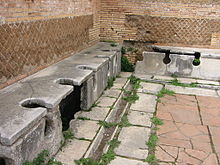

During the third millennium BC, toilets and sewers were invented. The Indus Valley Civilisation in northwestern India and Pakistan was home to the world's first known urban sanitation systems. In Mohenjo-Daro (c. 2800 BC), toilets were built into the outer walls of homes. These toilets had vertical chutes, via which waste was disposed of into cesspits or street drains. Another typical example is the Indus city of Lothal (c. 2350 BCE). In Lothal all houses had their own private toilet which was connected to a covered sewer network constructed of brickwork held together with a gypsum-based mortar that emptied either into the surrounding water bodies or alternatively into cesspits, the latter of which were regularly emptied and cleaned.
The Indus Valley Civilization also had water-cleaning toilets that used flowing water in each house that were linked with drains covered with burnt clay bricks. The flowing water removed the human waste. The Indus Valley civilisation had a network of sewers built under grid pattern streets.
Other very early toilets that used flowing water to remove the waste are found at Skara Brae in Orkney, Scotland, which was occupied from about 3100 BC until 2500 BC. Some of the houses there have a drain running directly beneath them, and some of these had a cubicle over the drain. Around the 18th century BC, toilets started to appear in Minoan Crete, Pharaonic Egypt, and ancient Persia.
In 2012, archaeologists found what is believed to be Southeast Asia's earliest latrine during the excavation of a neolithic village in the Rạch Núi archaeological site, southern Vietnam. The toilet, dating back 1500 BC, yielded important clues about early Southeast Asian society. More than 30 coprolites, containing fish and shattered animal bones, provided information on the diet of humans and dogs, and on the types of parasites each had to contend with.
In Roman civilization, toilets using flowing water were sometimes part of public bath houses. Roman toilets, like the ones pictured here, are commonly thought to have been used in the sitting position. The Roman toilets were probably elevated to raise them above open sewers which were periodically "flushed" with flowing water, rather than elevated for sitting. Romans and Greeks also used chamber pots, which they brought to meals and drinking sessions. Johan J. Mattelaer said, "Plinius has described how there were large receptacles in the streets of cities such as Rome and Pompeii into which chamber pots of urine were emptied. The urine was then collected by fullers." (Fulling was a vital step in textile manufacture.)
The Han dynasty in China two thousand years ago used pig toilets.
Post-classical history
Garderobes were toilets used in the Post-classical history, most commonly found in upper-class dwellings. Essentially, they were flat pieces of wood or stone spanning from one wall to the other, with one or more holes to sit on. These were above chutes or pipes that discharged outside the castle or Manor house. Garderobes would be placed in areas away from bedrooms to shun the smell and also near kitchens or fireplaces to keep the enclosure warm.
-
 Garderobe seat openings
Garderobe seat openings
-
 View looking down into garderobe seat opening
View looking down into garderobe seat opening
-
 Exterior view of garderobe at Campen castle
Exterior view of garderobe at Campen castle
-
 Toilet in Rosenborg Castle Copenhagen
Toilet in Rosenborg Castle Copenhagen
The other main way of handling toilet needs was the chamber pot, a receptacle, usually of ceramic or metal, into which one would excrete waste. This method was used for hundreds of years; shapes, sizes, and decorative variations changed throughout the centuries. Chamber pots were in common use in Europe from ancient times, even being taken to the Middle East by medieval pilgrims.
Modern history



By the Early Modern era, chamber pots were frequently made of china or copper and could include elaborate decoration. They were emptied into the gutter of the street nearest to the home.
In pre-modern Denmark, people generally defecated on farmland or other places where the human waste could be collected as fertilizer. The Old Norse language had several terms for referring to outhouses, including garðhús (yard house), náð-/náða-hús (house of rest), and annat hús (the other house). In general, toilets were functionally non-existent in rural Denmark until the 18th century.
By the 16th century, cesspits and cesspools were increasingly dug into the ground near houses in Europe as a means of collecting waste, as urban populations grew and street gutters became blocked with the larger volume of human waste. Rain was no longer sufficient to wash away waste from the gutters. A pipe connected the latrine to the cesspool, and sometimes a small amount of water washed waste through. Cesspools were cleaned out by tradesmen, known in English as gong farmers, who pumped out liquid waste, then shovelled out the solid waste and collected it during the night. This solid waste, euphemistically known as nightsoil, was sold as fertilizer for agricultural production (similarly to the closing-the-loop approach of ecological sanitation).
The garderobe was replaced by the privy midden and pail closet in early industrial Europe.
In the early 19th century, public officials and public hygiene experts studied and debated sanitation for several decades. The construction of an underground network of pipes to carry away solid and liquid waste was only begun in the mid 19th-century, gradually replacing the cesspool system, although cesspools were still in use in some parts of Paris into the 20th century. Even London, at that time the world's largest city, did not require indoor toilets in its building codes until after the First World War.
The water closet, with its origins in Tudor times, started to assume its currently known form, with an overhead cistern, s-bends, soil pipes and valves around 1770. This was the work of Alexander Cumming and Joseph Bramah. Water closets only started to be moved from outside to inside of the home around 1850. The integral water closet started to be built into middle-class homes in the 1860s and 1870s, firstly on the principal bedroom floor and in larger houses in the maids' accommodation, and by 1900 a further one in the hallway. A toilet would also be placed outside the back door of the kitchen for use by gardeners and other outside staff such as those working with the horses. The speed of introduction was varied, so that in 1906 the predominantly working class town of Rochdale had 750 water closets for a population of 10,000.
The working-class home had transitioned from the rural cottage, to the urban back-to-back terraces with external rows of privies, to the through terraced houses of the 1880 with their sculleries and individual external WC. It was the Tudor Walters Report of 1918 that recommended that semi-skilled workers should be housed in suburban cottages with kitchens and internal WC. As recommended floor standards waxed and waned in the building standards and codes, the bathroom with a water closet and later the low-level suite, became more prominent in the home.
Before the introduction of indoor toilets, it was common to use the chamber pot under one's bed at night and then to dispose of its contents in the morning. During the Victorian era, British housemaids collected all of the household's chamber pots and carried them to a room known as the housemaids' cupboard. This room contained a "slop sink", made of wood with a lead lining to prevent chipping china chamber pots, for washing the "bedroom ware" or "chamber utensils". Once running water and flush toilets were plumbed into British houses, servants were sometimes given their own lavatory downstairs, separate from the family lavatory. The practice of emptying one's own chamber pot, known as slopping out, continued in British prisons until as recently as 2014 and was still in use in 85 cells in the Republic of Ireland in July 2017.
With rare exceptions, chamber pots are no longer used. Modern related implements are bedpans and commodes, used in hospitals and the homes of invalids.
Development of dry earth closets
Further information: Dry toilet § History
Before the widespread adoption of the flush toilet, there were inventors, scientists, and public health officials who supported the use of "dry earth closets" - nowadays known either as dry toilets or composting toilets.
Development of flush toilets
Further information: Flush toilet § HistoryAlthough a precursor to the flush toilet system which is widely used nowadays was designed in 1596 by John Harington, such systems did not come into widespread use until the late nineteenth century. With the onset of the industrial revolution and related advances in technology, the flush toilet began to emerge into its modern form. A crucial advance in plumbing, was the S-trap, invented by the Scottish mechanic Alexander Cummings in 1775, and still in use today. This device uses the standing water to seal the outlet of the bowl, preventing the escape of foul air from the sewer. It was only in the mid-19th century, with growing levels of urbanisation and industrial prosperity, that the flush toilet became a widely used and marketed invention. This period coincided with the dramatic growth in the sewage system, especially in London, which made the flush toilet particularly attractive for health and sanitation reasons.
Flush toilets were also known as "water closets", as opposed to the earth closets described above. WCs first appeared in Britain in the 1880s, and soon spread to Continental Europe. In America, the chain-pull indoor toilet was introduced in the homes of the wealthy and in hotels in the 1890s. William Elvis Sloan invented the Flushometer in 1906, which used pressurized water directly from the supply line for faster recycle time between flushes.
High-tech toilet
See also: Toilets in Japan"High-tech" toilets, which can be found in countries like Japan, include features such as automatic-flushing mechanisms; water jets or "bottom washers"; blow dryers, or artificial flush sounds to mask noises. Others include medical monitoring features such as urine and stool analysis and the checking of blood pressure, temperature, and blood sugar. Some toilets have automatic lid operation, heated seats, deodorizing fans, or automated replacement of paper toilet-seat-covers. Interactive urinals have been developed in several countries, allowing users to play video games. The "Toylet", produced by Sega, uses pressure sensors to detect the flow of urine and translates that into on-screen action.
Astronauts on the International Space Station use a space toilet with urine diversion which can recover potable water.
Names
See also: Toilet (room) § Names, and Outhouse § Names
Etymology


Toilet was originally a French loanword (first attested in 1540) that referred to the toilette ("little cloth") draped over one's shoulders during hairdressing. During the late 17th century, the term came to be used by metonymy in both languages for the whole complex of grooming and body care that centered at a dressing table (also covered by a cloth) and for the equipment composing a toilet service, including a mirror, hairbrushes, and containers for powder and makeup. The time spent at such a table also came to be known as one's "toilet"; it came to be a period during which close friends or tradesmen were received as "toilet-calls".
The use of "toilet" to describe a special room for grooming came much later (first attested in 1819), following the French cabinet de toilet. Similar to "powder room", "toilet" then came to be used as a euphemism for rooms dedicated to urination and defecation, particularly in the context of signs for public toilets, as on trains. Finally, it came to be used for the plumbing fixtures in such rooms (apparently first in the United States) as these replaced chamber pots, outhouses, and latrines. These two uses, the fixture and the room, completely supplanted the other senses of the word during the 20th century except in the form "toiletries".
Contemporary use
The word "toilet" was by etymology a euphemism, but is no longer understood as such. As old euphemisms have become the standard term, they have been progressively replaced by newer ones, an example of the euphemism treadmill at work. The choice of word relies not only on regional variation, but also on social situation and level of formality (register) or social class. American manufacturers show an uneasiness with the word and its class attributes: American Standard, the largest firm, sells them as "toilets", yet the higher priced products of the Kohler Company, often installed in more expensive housing, are sold as commodes or closets, words which also carry other meanings. Confusingly, products imported from Japan such as TOTO are referred to as "toilets", even though they carry the cachet of higher cost and quality. (Toto, an abbreviation of Tōyō Tōki (東洋陶器 Oriental Ceramics), is used in Japanese comics to visually indicate toilets or other things that look like toilets; see Toilets in Japan.)
Regional variants
Different dialects use "bathroom" and "restroom" (American English), "bathroom" and "washroom" (Canadian English), and "WC" (an initialism for "water closet"), "lavatory" and its abbreviation "lav" (British English). Euphemisms for the toilet that bear no direct reference to the activities of urination and defecation are ubiquitous in modern Western languages, reflecting a general attitude of unspeakability about such bodily function. These euphemistic practices appear to have become pronounced following the emergence of European colonial practices, which frequently denigrated colonial subjects in Africa, Asia and South America as 'unclean'.
Euphemisms
"Crapper" was already in use as a coarse name for a toilet, but it gained currency from the work of Thomas Crapper, who popularized flush toilets in England.
"The Jacks" is Irish slang for toilet. It perhaps derives from "jacques" and "jakes", an old English term.
"Loo" – The etymology of loo is obscure. The Oxford English Dictionary notes the 1922 appearance of "How much cost? Waterloo. Watercloset." in James Joyce's novel Ulysses and defers to Alan S. C. Ross's arguments that it derived in some fashion from the site of Napoleon's 1815 defeat. In the 1950s the use of the word "loo" was considered one of the markers of British upper-class speech, featuring in a famous essay, "U and non-U English". "Loo" may have derived from a corruption of French l'eau ("water"), gare à l'eau ("mind the water", used in reference to emptying chamber pots into the street from an upper-story window), lieu ("place"), lieu d'aisance ("place of ease", used euphemistically for a toilet), or lieu à l'anglaise ("English place", used from around 1770 to refer to English-style toilets installed for travelers). Other proposed etymologies include a supposed tendency to place toilets in room 100 (hence "loo") in English hotels, a dialectical corruption of the nautical term "lee" in reference to the need to urinate and defecate with the wind prior to the advent of head pumps, or the 17th-century preacher Louis Bourdaloue, whose long sermons at Paris's Saint-Paul-Saint-Louis prompted his parishioners to bring along chamber pots.
Gallery
-
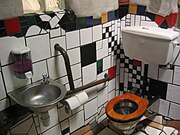 Men's toilet designed by artist and architect Hundertwasser
Men's toilet designed by artist and architect Hundertwasser
-
Toilet in Delftware style
-
Toilet bus in Samsun, Turkey
-
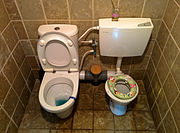 Duo toilet for child training in a banquet hall near Jerusalem, Israel
Duo toilet for child training in a banquet hall near Jerusalem, Israel
-
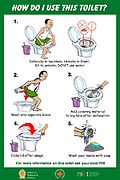 Instructions on using a urine-diverting dry toilet in Sri Lanka
Instructions on using a urine-diverting dry toilet in Sri Lanka
See also
- Sulabh International Museum of Toilets
- Sustainable Sanitation Alliance
- Toilet humour
- Toilet-related injuries and deaths
- World Toilet Day
Notes
- For a full list of English synonyms, see "toilet" at Wikisaurus.
- The French eau de toilette ("toilet water") is sometimes used as a sophisticated synonym for perfume and cologne but is generally received jokingly, as with Cosmopolitan's parody "If it doesn't say 'eau de toilette' on the label, it most likely doesn't come from the famed region of Eau de Toilette in France and might not even come from toilets at all."
- Yachtsmen still tend to refer to their toilets as "loos" rather than "heads".
References
- ^ Tilley, Elizabeth; Ulrich, Lukas; Lüthi, Christoph; Reymond, Philippe; Zurbrügg, Chris (2014). Compendium of Sanitation Systems and Technologies (2nd ed.). Duebendorf, Switzerland: Swiss Federal Institute of Aquatic Science and Technology (Eawag). ISBN 978-3-906484-57-0.
- ^ WHO and UNICEF (2017) Progress on Drinking Water, Sanitation and Hygiene: 2017 Update and SDG Baselines. Geneva: World Health Organization (WHO) and the United Nations Children’s Fund (UNICEF), 2017
- Wang, Jing (n.d.). . Retrieved 2019-11-19.
{{cite web}}: Check|url=value (help) - ^ Shaw, R. (2014). A Collection of Contemporary Toilet Designs. EOOS and WEDC, Loughborough University, UK. p. 40. ISBN 978-1-84380-155-9.
- "World Toilet Day 19 November". United Nations. Retrieved 14 November 2017.
- "Tucson lawmaker wants tax credits for water-conserving toilet". Cronkite News Service. Retrieved 2008-03-12.
- ^ "Aircraft Toilets / Toilets of the World". Toilets of the World.
- "What are Vacuum Toilets?". wiseGEEK.
- "Vacuum Toilet | SSWM - Find tools for sustainable sanitation and water management!". sswm.info.
- "How does the toilet in a commercial airliner work?". HowStuffWorks. 1 April 2000.
- "EVAC Bus Vacuum Toilet". Evac GmbH.
- Gershenson, Olga; Penner, Barbara (2009): Ladies and gents - Public toilets and gender. Temple University Press, Philadelphia, Pennsylvania.
- Kira A. The Bathroom. Harmondsworth: Penguin, 1976, revised edition, pp.115,116.
- von Münch, E.; Milosevic, D. (2015): Qualitative survey on squatting toilets and anal cleansing with water with a special emphasis on Muslim and Buddhist countries by using the SuSanA discussion forum. Ostella Consulting, Schwalbach, Germany
- Y. de Jong. "Influence of voiding posture on urodynamic parameters in men: a literature review (in Dutch)" (PDF). Nederlands Tijdschrift voor urologie. Retrieved 2014-07-02.
- Shu'aib, Tajuddin B., "Qadaahul Haajah (Relieving Oneself)", The Prescribed Prayer Made Simple, MSA West Compendium of Muslim Texts, archived from the original on 2009-08-19, retrieved 2009-03-10
- "Eight surprisingly rude gestures to avoid when travelling". News.com.au. November 21, 2013. Retrieved 17 July 2016.
- manic. "World Toilet". World Toilet. Retrieved 2016-03-07.
- WHO and UNICEF Progress on Sanitation and Drinking-water: 2013 Update Archived 2014-04-18 at the Wayback Machine, WHO, Geneva and UNICEF, New York
- manic. "World Toilet". World Toilet. Retrieved 2016-03-07.
- Whitaker, Mark. 30 June 2007. "Why Uganda hates the plastic bag." BBC News via news.bbc.co.uk. Retrieved on 28 September 2007.
- "Sample Designs: Floating UDD Toilets". Asian Development Bank.
- Article, Govt: Bt900bn needed (in Thailand), The Nation October 31, 2011
- Cain, Geoffrey. (April 19, 2010). "Floating toilets to clean up Cambodia's act". Global Post.
- Environmental History of Water, p.40
- Teresi et al. 2002
- Khan, Saifullah. "1 Chapter 2 Sanitation and wastewater technologies in Harappa/Indus valley civilization ( ca . 2600-1900 BC)". Academia.edu. Academia.edu. Retrieved 9 April 2015.
{{cite web}}: External link in|ref= - "Maya plumbing: First pressurized water feature found in New World". Penn State. May 5, 2010. Retrieved 26 March 2014.
- Old toilet find offers civilization start clues. Stuff.co.nz. Retrieved 28 September 2013.
- Time capsule. Viet Nam News. Retrieved 28 September 2013.
- Asia’s First Toilet Discovered In Southern Viet Nam. Asian Scientist. Retrieved 28 September 2013.
- Mattelaer, Johan J. "Some Historical Aspects of Urinals and Urine Receptacles." World Journal of Urology 17.3 (1999): 145–50. Print.
- ^ Genc, Melda. "The Evolution of Toilets and Its Current State." Thesis. Middle East Technical University, 2009. Harold B. Lee Library. Brigham Young University, 2009. Web. 28 Nov. 2011.
- "Middle Ages Hygiene." Middle Ages. The Middle Ages Website. Web. 28 Nov. 2011.
- Powell, Christine A. "Port Royal Chamberpots Introduction." Nautical Archaeology at Texas A&M University. Texas A&M University, 1 Dec. 1996. Web. 28 Nov. 2011.
- Setton, Kenneth M.; Harry W. Hazard (1977). A History of the Crusades, Volume IV: The Art and Architecture of the Crusader States. University of Wisconsin Press. p. 47. ISBN 978-0-299-06824-0.
{{cite book}}: Unknown parameter|lastauthoramp=ignored (|name-list-style=suggested) (help) - ^ Newitz, Annalee (June 22, 2017). "Unexpected Viking toilet discovery leads to controversy". Ars Technica.
- La Berge, Ann Elizabeth Fowler (2002). Mission and Method: The Early Nineteenth-Century French Public Health Movement. Cambridge University Press. pp. 207–9. ISBN 978-0-521-52701-9.
- ^ Powell, John Burnett ; illustrated by Christopher (1986). A social history of housing, 1815-1985 (2nd. ed.). London: Methuen. p. 214. ISBN 0416367704.
{{cite book}}: CS1 maint: multiple names: authors list (link) - Powell, John Burnett ; illustrated by Christopher (1986). A social history of housing, 1815-1985 (2nd. ed.). London: Methuen. pp. 336, 337. ISBN 0416367704.
{{cite book}}: CS1 maint: multiple names: authors list (link) - Flanders, Judith (2003). The Victorian House. London: HarperCollins. p. 64. ISBN 0-00-713189-5.
- Cole, Paul (26 October 2014). "Brutal sex killer claims having to slop out cell breaches his human rights". birminghammail. Retrieved 8 January 2018.
- "Slopping out ended in Cork Prison | Irish Penal Reform Trust (IPRT)". www.iprt.ie. Retrieved 8 January 2018.
- "Fordington, Biography, Rev Henry Moule, 1801-1880". freepages.genealogy.rootsweb.ancestry.com. Archived from the original on 2011-05-09. Retrieved 2017-03-29.
- Geere, Duncan. (6 January 2011). "'Toylet' Games in Japan's Urinals". Wired UK. Retrieved 20 January 2011.
- "Gives Space Station Crew 'Go' to Drink Recycled Water". www.nasa.gov. Retrieved 2017-10-30.
- See Egerton op cit
- ^ "toilet, n.", Oxford English Dictionary, Oxford: Oxford University Press.
- Egerton, Judy (1998), "The British School", National Gallery Catalogues, New Series, p. 167, ISBN 1-85709-170-1.
- Pope, Alexander (1717), The Rape of the Lock.
- See, e.g., the description of the Hogarth painting "The Toilette" from his Marriage à-la-mode series in Egerton or the extensive discussion of a lady's toilet in Pope.
- "The honest Jakes or Privy has graduated via Offices to the final horror of Toilet" – Vicar Bell,
- Alison Moore, Colonial Visions of ‘Third World’ Toilets: A Nineteenth-Century Discourse That Haunts Contemporary Tourism. In Olga Gershenson and Barbara Penner (eds.), Ladies and Gents: Public Toilets and Gender (Philadelphia: Temple University Press, 2009), 97-113.
- Anderson, Warwick (2010). "Crap on the map, or postcolonial waste". Postcolonial Studies. 13 (2): 169–178. doi:10.1080/13688790.2010.496436. ISSN 1368-8790.
- "BBC h2g2". Retrieved 25 June 2013.
- "Toilet Inspector". Retrieved 25 June 2013.
- ^ "loo, n.⁴", Oxford English Dictionary.
- Ross, Alan S.C. (October 1974), Blackwood's Magazine, pp. 309–316.
- Ross, Alan S.C. (1954), "Linguistic Class-Indicators in Present-Day English", Neuphilologische Mitteilungen, vol. 55, Helsinki, pp. 113–149
{{citation}}: CS1 maint: location missing publisher (link). - Ashenburg, p. 138. sfn error: no target: CITEREFAshenburg (help)
- Harper, Douglas. "loo". Online Etymology Dictionary..
- "Why do they call it the loo?", Kottke, 16 February 2005, retrieved 1 August 2015.
- "Chamber Pots". Muzeum historických nočníků a toalet. Retrieved 17 July 2016.